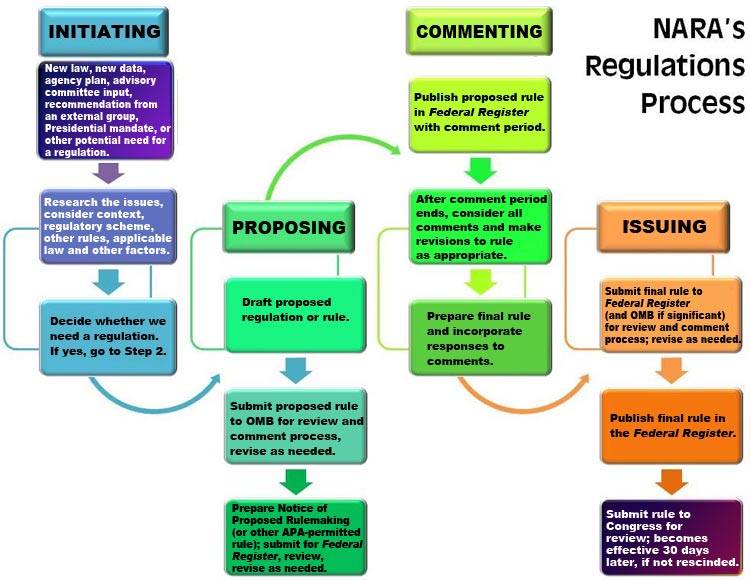
NARA's Regulatory Process
How does NARA develop regulations?
The process of creating Federal regulations is generally referred to as the "rulemaking" process.
First, Congress passes a law designed to address a social or economic need or problem. The law authorizes a specific agency to be responsible for the law, including developing any necessary regulations to carry it out. Acts such as these are known as "enabling legislation," because they enable the Federal agency to create the regulations required to administer them. They are also sometimes called the "authority" for the agency's regulations.
When the enabling legislation authorizes NARA to develop regulations, we first ask if a regulation is needed at all. Every regulation is developed or revised under slightly different circumstances, but this is the general process: 
Step 1: Initiating
We research whether or not a regulation is needed. There are a number of ways a need for a regulation might develop. Sometimes, the law specifically tells us to develop regulations. We may also develop procedures or standards for a program we oversee and decide that those should be published so everyone can follow them. Other times, we may get information that there is confusion or difficulty in a certain area and we think a regulation might help clear it up. Sometimes, a new law is enacted or an Executive order is issued that changes something we have in one of our already-existing regulations so we issue a revision.
Step 2: Proposing
Once we determine that a regulation, or a revision to a regulation, is necessary, we usually prepare a Notice of Proposed Rulemaking (NPRM). This is an official document that is published in the Federal Register so that the public can see it and comment on it. It is also filed in NARA's docket online at www.regulations.gov. Although this document is called a notice because it lets people know we are proposing a regulation, it is actually a rough draft of what we think should be in the regulation.
Sometimes, we issue a regulation or a revision that is minor and mostly administrative. In those cases, we may instead issue what is called a "direct-to-final" rule. This means that we think that the change is so minor there probably won't be any adverse comment on it. This draft of the proposed regulation is therefore set up to become final automatically after the comment period if we receive no adverse comments. If we receive adverse comments, we withdraw the regulation and process the comments as described in Step 3.
Step 3: Commenting
Most proposed regulations we develop have a 60-day comment period. During this time, people and organizations can comment on the proposed rule at www.regulations.gov, by fax, by mail, or by hand delivery (contact information under Submitting Comments). Direct-to-final rules usually have a shorter comment period of 30 days.
We welcome comments from the public and from other agencies that may be affected by our proposed regulation. Comments can tell us that there is agreement or support for what we are proposing, or disagreement, and why. They can also provide us with new information or other points of view to consider, and with suggestions for ways in which to make the regulation stronger or more effective. This can be especially important in cases where we are proposing a rule that affects a variety of different groups or individuals.
We read and consider all comments we receive during the comment period. Once we consider the comments, we often revise the regulation to include recommended changes. Whether we change the regulation or not, we address the comments we have received and explain our response to them.
Step 4: Issuing
Once we have considered any comments and made possible revisions to the regulation, we issue a final rule, which is another official document published in the Federal Register and at NARA's docket on www.regulations.gov. The final rule includes information on what comments we received on the draft and how we responded to them. After the final rule is published in the Federal Register (or, for direct-to-final rules, at the end of the comment period if no adverse comments are received), Congress reviews the rule, and, if Congress does not overrule the rule, it is finally added to the Code of Federal Regulations (CFR).
How does NARA develop regulations for the Federal Register and Code of Federal Regulations?
The Federal Register Act (44 U.S.C. chapter 15) established the Administrative Committee of the Federal Register (ACFR). The members of the ACFR are the Archivist of the United States, the Public Printer of the United States, and an officer of the Department of Justice designated by the Attorney General. Under this statute, the ACFR is authorized to issue regulations governing the publication of documents in the Federal Register and Code of Federal Regulations.
Proposed and final regulations are drafted by the attorneys at the Office of the Federal Register (Federal Register) with the assistance of the Federal Register's editorial and senior staff. Once the draft has been cleared through the Director of the Federal Register, it is sent to the members of the ACFR for comment. Once all 3 members of the ACFR agree on the text of the proposed or final rule, they all sign it. After the members of the ACFR sign the document, the Archivist and Attorney General sign it as required by Executive Order 10530. Once all members of the ACFR, the Archivist, and the Attorney General have signed the rule, the Federal Register's legal staff officially submits it to the Federal Register editorial staff for publication in the Federal Register.
ACFR Regulatory Process Flow Chart
Would you like to learn more about:
- How to submit comments on proposed Federal rules and regulations?
- What NARA's process is for developing, reviewing, and approving regulations?
- Answers to frequently asked questions about regulations?
- Some other resources for information on laws and regulations?
- How to submit a suggestion or idea to NARA on any subject, including regulations?